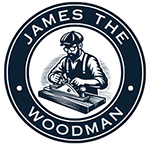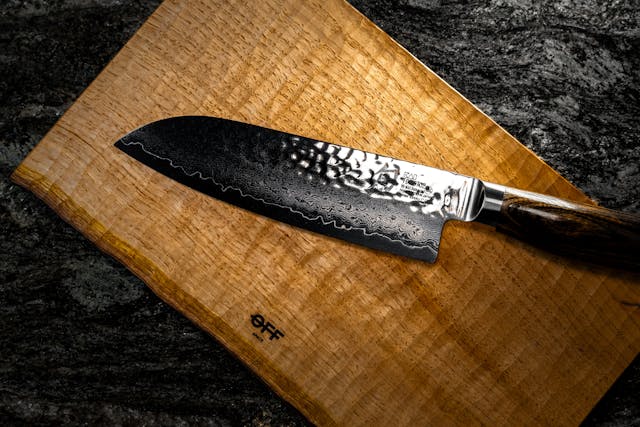Choosing the right knife for your kitchen tasks is essential, but pairing it with the correct cutting surface is just as important. Wooden cutting boards are favoured by professional chefs and home cooks alike for their durability, gentle surface, and aesthetic appeal. However, the type of knife you use on a wooden cutting board can affect both the longevity of the board and the performance of your knife. Using the right knife helps preserve your tools and improve your cooking efficiency. This article explores the best types of knives to use with wooden cutting boards, based on material compatibility, performance, and durability.
Why Wooden Cutting Boards Are Preferred
Before discussing the best knives to use, it’s important to understand why wooden cutting boards are widely recommended. Wood is naturally resilient and self-healing. Small knife marks often close up over time, which means the surface remains smoother for longer. High-quality hardwood boards, such as those made from maple, walnut, or teak, are also less likely to dull your knives compared to plastic or glass alternatives.
Wooden boards are also more hygienic than many assume. Research from the University of Wisconsin has shown that bacteria do not survive well on wood surfaces, especially if the board is properly cleaned and maintained. When used with the right knives, wooden boards provide an optimal surface for food preparation.
Knife Materials Matter
The compatibility of a knife with a wooden cutting board depends largely on the knife’s material. There are three primary types of knife blades: stainless steel, carbon steel, and ceramic. Each interacts differently with wood.
Stainless steel knives are a versatile and popular option. They resist rust and are durable, making them an excellent choice for use on wooden boards. However, lower-quality stainless steel can lose its edge quickly.
Carbon steel knives hold a sharper edge for longer and are preferred by professional chefs for their precision. However, they are more prone to rust and require careful maintenance. Carbon steel works well on wooden boards as the surface is gentle enough to prevent premature dulling.
Ceramic knives are extremely sharp and maintain their edge for a long time. However, they are brittle and prone to chipping or breaking, especially when used on a harder surface. Wooden cutting boards are one of the few suitable surfaces for ceramic knives, but the knives must still be used with caution.
Best Knife Types for Use with Wooden Boards
When selecting a knife to use with your wooden cutting board, it’s helpful to match the knife type to the task at hand. The following knives are ideal choices, both for their function and their compatibility with wood surfaces:
Chef’s Knife
The chef’s knife is the workhorse of any kitchen. With a blade typically ranging from 15 to 25 centimetres in length, it is used for chopping, slicing, dicing, and mincing. A high-quality chef’s knife made from stainless or carbon steel is perfect for use on a wooden board. The broad blade and balanced weight allow smooth cutting motions, which the wooden surface can absorb without causing damage to the edge.
Santoku Knife
Originating from Japan, the Santoku knife is similar to a chef’s knife but features a flatter edge and a more compact blade. It excels at precision cuts, especially for vegetables, fish, and boneless meats. The smooth glide of a Santoku over a wooden board protects both the blade and the surface, making this pairing a favourite among those who prepare a lot of stir-fry or sushi ingredients.
Paring Knife
A paring knife is essential for small, intricate tasks such as peeling, trimming, or deveining. Wooden cutting boards provide a forgiving surface for this small blade, reducing wear and tear. Whether you’re coring a tomato or segmenting citrus, a paring knife works best when used on a soft, even board like wood.
Bread Knife
Bread knives have long, serrated blades designed to slice through crusty bread without crushing the interior. Wooden boards help reduce the friction on these serrated edges, which are more challenging to sharpen. Using a bread knife on a hard surface like glass or marble can quickly wear down the teeth, but a wooden surface keeps the blade in better condition.
Utility Knife
Utility knives serve as a bridge between paring knives and chef’s knives. They are ideal for slicing sandwiches, cutting cheese, or trimming meat. A wooden board provides an appropriate surface for the varied tasks a utility knife handles, preserving the blade and ensuring cleaner cuts.
Knives to Avoid or Use with Caution
While many knives work well with wooden boards, some should be used with care:
- Cleavers: These heavy-duty knives can damage even the sturdiest wooden boards if used improperly. Use a thick end-grain wooden board if cleavers are a regular part of your cooking.
- Serrated knives for aggressive tasks: Not all serrated knives are suited for wooden boards. Aggressive use can leave deep grooves in the board, which can trap bacteria and affect hygiene.
Proper Knife Maintenance for Use with Wooden Boards
Even when used with the right cutting surface, knives require regular maintenance to stay in peak condition. The following tips help prolong the life of your knives when used with wooden boards:
- Hone your knives regularly: Use a honing rod to keep the edge aligned.
- Sharpen when necessary: Depending on usage, sharpen your knives every 6–12 months.
- Hand wash only: Avoid dishwashers, as the heat and detergents can damage the blade.
- Dry immediately after washing: Prevent rust and corrosion, especially on carbon steel blades.
Additionally, wooden boards should be cleaned with mild soap and warm water, dried thoroughly, and oiled regularly with food-grade mineral oil to maintain their surface.
End-Grain vs Edge-Grain Boards
The type of wooden board you use also affects how your knife interacts with it. End-grain boards, made from the cross-section of wood, are more forgiving on knife edges and self-heal more effectively. Edge-grain boards, made from the lengthwise cut of wood, are more affordable and still knife-friendly but wear down faster.
Choosing a quality end-grain board paired with a properly maintained knife is one of the best combinations for serious cooking.
Get A Wooden Cutting Board from James
The best knives to use with wooden cutting boards are those made from high-quality stainless or carbon steel and designed for specific culinary tasks. Chef’s knives, Santoku knives, paring knives, and bread knives are all excellent choices when paired with wooden surfaces. Wooden boards protect knife edges better than harder surfaces, enhancing both the performance and lifespan of your blades. By choosing the right knife and maintaining it properly, you ensure safer, more efficient food preparation and preserve the integrity of your wooden cutting board for years to come.

